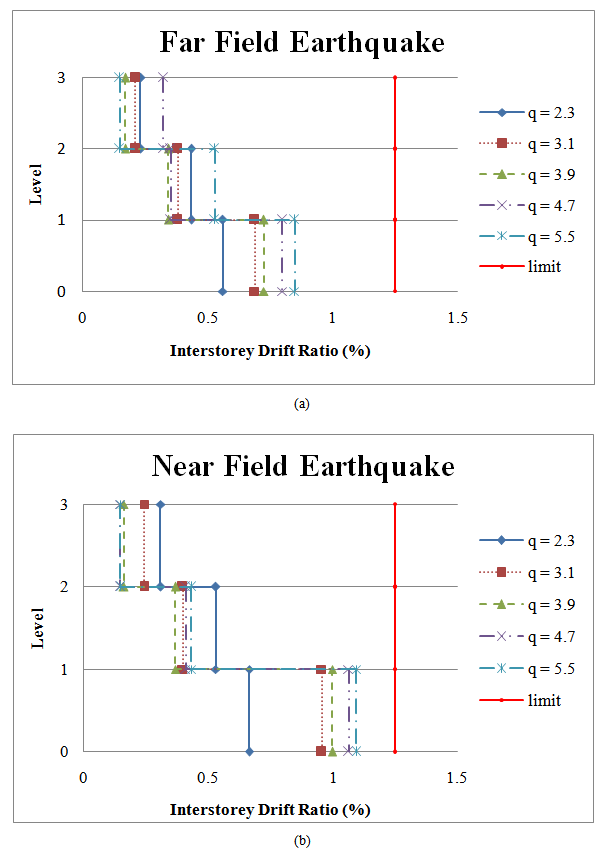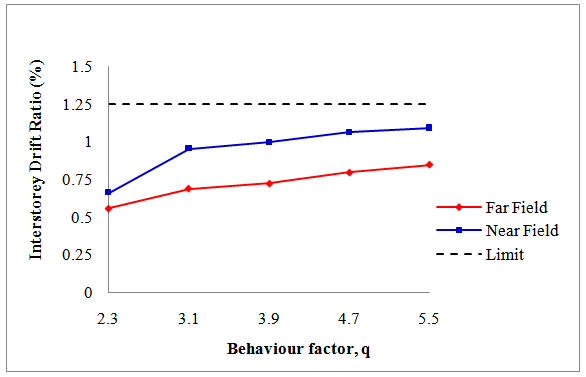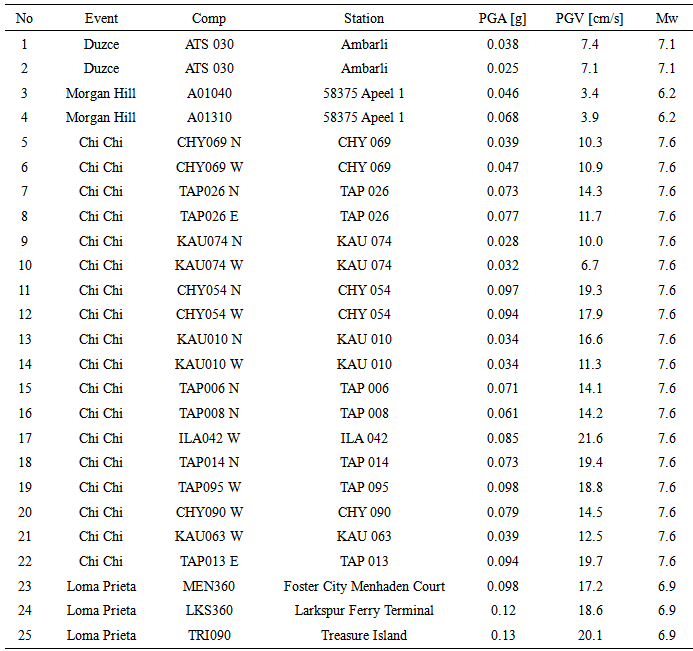-
Paper Information
- Next Paper
- Previous Paper
- Paper Submission
-
Journal Information
- About This Journal
- Editorial Board
- Current Issue
- Archive
- Author Guidelines
- Contact Us
Journal of Civil Engineering Research
p-ISSN: 2163-2316 e-ISSN: 2163-2340
2014; 4(3A): 130-134
doi:10.5923/c.jce.201402.22
Nonlinear Response of Low Rise Hospital RC Building in Malaysia Due to Far and Near Field Earthquake
Taksiah A. Majid1, Mohd Irwan Adiyanto2, Fadzli Mohamed Nazri1
1Disaster Research Nexus, School of Civil Engineering, Universiti Sains Malaysia, Penang, Malaysia
2Postgraduate Student, School of Civil Engineering, Penang, Malaysia
Correspondence to: Fadzli Mohamed Nazri, Disaster Research Nexus, School of Civil Engineering, Universiti Sains Malaysia, Penang, Malaysia.
| Email: |  |
Copyright © 2014 Scientific & Academic Publishing. All Rights Reserved.
Geographically, Malaysia is situated in relatively far away from active seismic fault zones. Therefore, the earthquake hazard is not exist in Malaysian dictionary of life before the new century. Therefore, seismic consideration is not required in public buildings design. However, since a shock from a gigantic Mw 9.0 earthquake in Aceh, Indonesia on 26 December 2004, Malaysian authority and public citizen become aware of that hazard. The possibility to implement the seismic design start to be discussed at least for important structures such as bridge and dam. Hospital also cannot be ignored in discussion since the buildings is very important and must secure during disaster such as earthquake. This paper presents the study on the nonlinear response of three storey hospital reinforced concrete moment resisting frame designed for medium seismic region in Sabah, Malaysia. The typical frame had been designed according to Eurocode 8 for ductility class medium. The nonlinear response history analysis had been conducted on all five frames with far field and near field earthquake ground motion records as input. The result shows that the magnitude of interstorey drift ratio is strongly influenced by the value of behavior factor, q used in the design. The former is increases around 23% - 52% and 44% - 65% when subjected to the far field and near field earthquakes, respectively as the value of behavior factor, q is increases.
Keywords: Hospital, Reinforced concrete, Eurocode 8, Behaviour factor, Interstorey drift ratio
Cite this paper: Taksiah A. Majid, Mohd Irwan Adiyanto, Fadzli Mohamed Nazri, Nonlinear Response of Low Rise Hospital RC Building in Malaysia Due to Far and Near Field Earthquake, Journal of Civil Engineering Research, Vol. 4 No. 3A, 2014, pp. 130-134. doi: 10.5923/c.jce.201402.22.
Article Outline
1. Introduction
- Since the gigantic Mw 9.0 earthquake in Aceh, Indonesia on 26 December 2004 which also triggered tsunami in the Indian Ocean, Malaysian authority and public citizen start to rethink about the earthquake hazard toward the nation. After 10 years, the number of tremors which can be felt in Malaysian soil due to Sumatra Andaman and Philippines earthquakes is rising. A lot of researches had been conducted related the that field including the possibility of considering seismic design. According to Mosti report [1], it is worth to consider seismic design for construction of new structures located in medium to high seismic region. Experience from the past earthquakes gave a very useful lesson that hospitals and health care facilities are considered as the most important facilities which must remain safe and operable after the disaster [2]. Damages on the non-structural elements and equipment also can make the building inoperable. As an example, in the 1999 ChiChi Taiwan earthquake, the whole Shiu-Tuwan hospital was closed due to damages of non-structural elements even the damages on structure was not severe. After a significant earthquake, the victims turn to hospitals where they expect to receive treatment for any injuries during the event. Therefore, in every community’s post disaster plan, hospitals require special attention and should be the safest place because people’s lives depend on its functionality [3, 4]. To implement the seismic design in a developing country like Malaysia, the increment of cost also has to be taken into account. Due to economical reason, it is not practical to design structures that can behave elastically during earthquake [5]. This mean that the use of lateral force which had been derived based on elastic response spectrum for design purpose will result in very high cost of construction. Therefore, the concept of behaviour factor, q is proposed to reduce the force obtained from a linear analysis, in order to take into account the nonlinear response of a structure [6]. In American code [7], the concept of behaviour factor, q also proposed namely as force or strength reduction factor, R. The behaviour factor, q strongly influencing the class of ductility, namely as low, medium and high. According to Borzi and Elnashai [8], both European and American codes are too conservative where the ductility demand which corresponds to the behaviour factor, q is higher than the ductility supply. The forward directivity ground motions require smaller value of strength reduction factor, R compared to the non-forward directivity ground motions [9]. Therefore, Jalali and Trifunac [10] suggested that the simple and effective modification is needed to replace the current value of behaviour factor, q. This paper presents the nonlinear response of low rise hospital reinforced concrete (RC) building when subjected to the near and far field earthquakes. The typical three storey moment resisting frame (MRF) had been designed repeatedly based on different value of behaviour factor, q for ductility class medium (DCM). The seismic response is evaluated based on the value of interstorey drift ratio (IDR).
2. Material and Method
2.1. 2 Dimensional MRF Model
- In this study, the nonlinear response history analysis had been conducted on the three storey RC MRF. A total of five typical model had been designed based on five different value of behaviour factor, q. According to Eurocode 8 [6], the value of behaviour factor, q for ductility class low (DCL) is equal to 1.5. for DCM structure, the value of behaviour factor, q lies in range of 1.5 < q < 5.85 depend on the type of structure and material. The behaviour factor, q ≥ 5.85 is used for the ductility class high (DCH). Therefore, the typical frame had been designed repeatedly based on five value of behaviour factor, q equal to 2.3, 3.1, 3.9, 4.7, and 5.5 for DCM. The typical frame is regular in plan and elevation where the floor to floor height is equal to 3.3 m for each stories. The frame is completed by three equal bays of 5.0 m. since this study focus on hospital building, the typical frame is classified into important class IV where the importance factor, γI used for design is equal to 1.4. All frames had been designed based on reference peak ground acceleration, agR equal to 0.12g to represent to the medium seismic region in Sabah, Malaysia [1, 11].The size of beam located at top storey is equal to 250 mm x 550 mm while at the first and second storey is equal to 300 mm x 600 mm. The size for all columns is equal to 375 mm x 375 mm regardless its position either interior or exterior column. All five frames had been designed based on the aforementioned size of sections so that the dynamic characteristic of all frames is similar with fundamental period of vibration, T1 equal to 0.5 sec. All frames had been designed with seismic provision based on Eurocode 8 [6] with concrete compressive strength, fcu and steel yield strength, fy is equal to 30 N/mm2 and 500 N/mm2, respectively. The detail of steel reinforcement for all frames can be found elsewhere [12].
|
2.2. Nonlinear Response History Analysis
- In order to study the nonlinear response of low rise hospital RC MRF in Malaysia, the nonlinear response time history analysis had been conducted on all frames using Ruaumoko program [13]. The nonlinear response history analysis simulates the response of the frames when subjected to the real earthquake represented by dynamic load which varies against time. For that purpose, the program requires input in form of ground acceleration against time known as ground motion records. A total of 25 ground motion records which had been downloaded from PEER database [14] is shown in Table 1. The list of near field ground motion records can be found elsewhere [15].All ground motion records were recorded on soft soil with shear wave velocity, Vs < 180 m/s. Before being assembled as input in Ruaumoko program, all ground motion records had been scaled based on the spectral acceleration with damping ratio of 5% at the fundamental period of vibration, Sa(T1,5%). The scaling process was referred to the Type 1 response spectrum of Eurocode 8 [6] for Soil Type D developed based on the reference peak ground acceleration, agR as mentioned in previous subsection.
3. Result and Discussion
- The action of earthquake induces lateral displacement on the structures. Large lateral displacement will cause damage to the non-structural and structural elements and then lead to collapse. Performance-Based Earthquake Engineering (PBEE) concept proposed four different performance level which might be experienced by structures due to action of earthquake load. The performance level is namely as Operational (OP), Immediate Occupancy (IO), Life Safety (LS), and Near Collapse (NC) [16]. All performance levels can be evaluated through the magnitude of IDR, which can be expressed as the relative lateral displacement between two adjacent stories normalized to its storey height. The magnitude of IDR equal to 0.5%, 1.0%, 2.0%, and 4.0% indicates the OP, IO, LS, and NC performance level, respectively. Hospitals and health care facilities are considered as the most important facilities which must remain safe and operable after the disaster [2]. Hence, such buildings should be categorized as IO performance level. According Eurocode 8 [6], the IDR for structures in important class IV, such as hospital in this study is limited to 1.25%. Fig. 1(a) shows the distribution of IDR over the height of all three storey RC MRF used in this study when subjected to the far field earthquakes. Since a total of 25 ground motion records had been used in the nonlinear response history analysis, the magnitude of IDR presented here is the mean value. The frames designed based on lower behaviour factor, q experienced lower magnitude of IDR compared to the same frame designed with higher behaviour factor, q. For example, at the bottom storey, the IDR of frames designed with behaviour factor, q = 2.3 and q = 3.9 is equal to 0.56% and 0.72%, respectively. When designed based on behaviour factor, q = 5.5, the magnitude of IDR at same storey is rising to 0.85%. This trend is clear and indicates that frames designed with higher value of behaviour factor, q experienced larger lateral displacement compared to the frames designed with lower behaviour factor, q. This result is in good agreement with previous study which stated that the increase of force reduction factor, R always leads to an increase of the inelastic displacement ratio [17].The distribution of IDR over the height for all five frames due to action of near field earthquakes in shown in Fig. 1(b). It is also observed that the magnitude of IDR is higher for frames designed with higher behaviour factor, q. This proves that the latter is weaker which result in larger lateral displacement. At the bottom storey, the magnitude of IDR for frames designed with behaviour factor, q equal to 2.3, 3.1, and 3.9 is equal to 0.66%, 0.95%, and 1.0%, respectively. When designed based on behaviour factor, q equal to 4.7, and 5.5, the magnitude of IDR is increasing around 61% and 65% higher from the IDR of frame with the lowest behaviour factor, q. From Fig. 1(a) and Fig. 1 (b), it can be clearly observed that the distribution of IDR over the height is in typical form regardless the value of behaviour factor, q used in design. The type of ground motion record, neither far field nor near field earthquake also did not influencing the form of IDR distribution over the height. For all frames, the maximum IDR is concentrated at the bottom storey.
 | Figure 1. Interstorey drift ratio of 3 storey frame (a) Far Field Earthquake (b) Near Field Earthquake |
 | Figure 2. Maximum interstorey drift ratio of 3 storey frame |
4. Conclusions
- This paper presents the study on the nonlinear response of three storey hospital RC MRF designed for medium seismic region in Sabah, Malaysia. The typical frame had been designed according to Eurocode 8 [6] for DCM. Five different value of behaviour factor, q had been used for designed which is equal to 2.3, 3.1, 3.9, 4.7, and 5.5. Then, the nonlinear response history analysis had been conducted on all five frames with far field and near field ground motion records as input. The following conclusions can be drawn from this study:§ The value of behaviour factor, q used in design strongly influencing the magnitude of IDR where the latter is increases as the former is increases and concentrated at the bottom storey. § Due to far field earthquake, the magnitude of IDR is increases in range of 23% to 52% as the value of behaviour factor, q used in design is increases.§ Due to near field earthquake, the magnitude of IDR is increases in range of 44% to 65% as the value of behaviour factor, q used in design is increases.§ For all frames, it is observed that the action of near field earthquake caused greater IDR compared to the far field earthquake. § In this study, the magnitude IDR for all frames is below than the limit regardless the type of earthquake ground motion records, either far field or near field. Therefore, the design of all frames is acceptable in term of seismic performance. The cost evaluation is needed to find the most economic design.
ACKNOWLEDGEMENTS
- The authors gratefully acknowledge the facilities provided by Universiti Sains Malaysia and financial support from MyBrain15, a scholarship provided by Ministry of Education Malaysia to accomplish this study.
 Abstract
Abstract Reference
Reference Full-Text PDF
Full-Text PDF Full-text HTML
Full-text HTML